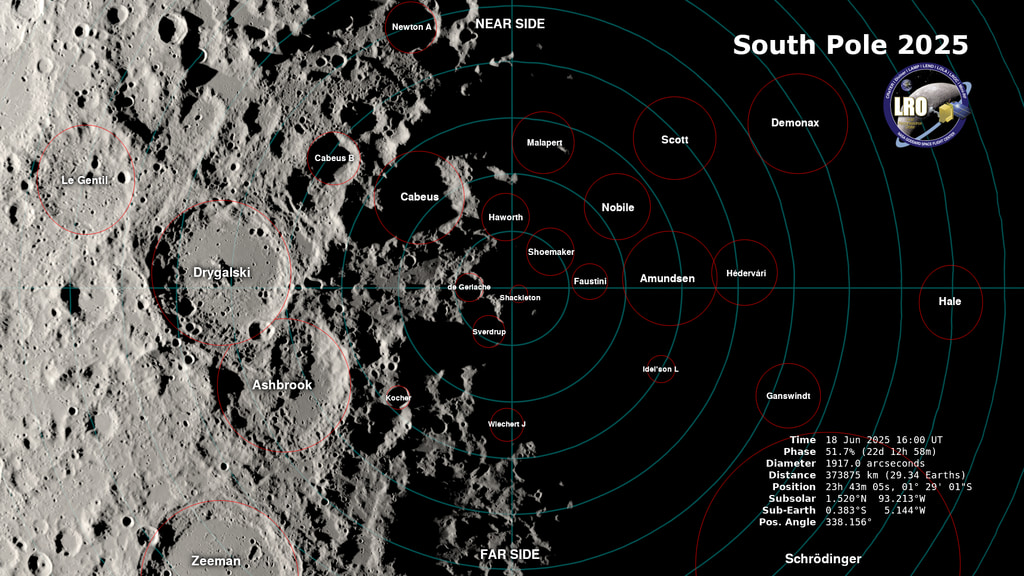Moon Essentials: Seasons
An animation of the Moon's seasons. The left half of the frame shows the 1.5° tilt of the Moon's axis (light blue) relative to the Sun. The right half shows the seasonal change in lighting at the Moon's South Pole.
The lunar South Pole will be the target of both robotic and human exploration missions in the coming years, and the timing of their arrival will be driven by, among other things, the seasonal ebb and flow of available sunlight there. Both the Earth and the Moon experience seasons caused by their axial tilt relative to the Sun. But while the Earth is tilted 23.5°, the tilt of the Moon is a mere 1.5°, making its seasonal changes quite subtle. As on Earth, the largest effect is at the poles.
In this visualization, the monthly rotation of the Moon has been frozen at full moon in order to highlight the small difference in axial tilt at South Pole summer and winter. The left half of the frame shows the western hemisphere of the Moon, including the Orientale basin on the terminator (day-night line). Only the lit half of this view is visible from Earth. The right half of the frame is an overhead view of the South Pole region, with the perfectly bowl-shaped Shackleton crater in the center. The near side (the side facing Earth) is up in this view.
The complete seasonal cycle on the Moon is its draconic year of about 346.6 Earth days. This is shorter than an Earth year because the Moon's orbit plane rotates once every 18.6 years, and its axis precesses at the same rate, bringing each season around somewhat faster than it would arrive otherwise.

A comparison of summer (left) and winter lighting at the South Pole of the Moon. The view has been shifted somewhat to reveal more of the nearside hemisphere.

A comparison of the summer (left) and winter axis tilt of the Moon. The red line is a vertical reference. The light blue line is the Moon's rotation axis.
Source frames for the left half of the composite movie showing the globe of the Moon as it tilts during summer and winter.
Source frames for the right half of the composite movie showing the seasonal lighting at the South Pole of the Moon.
Credits
Please give credit for this item to:
NASA's Scientific Visualization Studio
-
Visualizer
- Ernie Wright (USRA)
-
Scientist
- Timothy J. Stubbs (NASA/GSFC)
-
Technical support
- Laurence Schuler (ADNET Systems, Inc.)
- Ian Jones (ADNET Systems, Inc.)
Release date
This page was originally published on Friday, February 23, 2024.
This page was last updated on Thursday, June 27, 2024 at 4:55 PM EDT.
Missions
This visualization is related to the following missions:Series
This visualization can be found in the following series:Datasets used in this visualization
-
DEM (Digital Elevation Map) [LRO: LOLA]
ID: 653 -
DE421 (JPL DE421)
ID: 752Planetary ephemerides
This dataset can be found at: http://ssd.jpl.nasa.gov/?ephemerides#planets
See all pages that use this dataset -
LROC WAC Color Mosaic (Natural Color Hapke Normalized WAC Mosaic) [Lunar Reconnaissance Orbiter: LRO Camera]
ID: 1015This natural-color global mosaic is based on the 'Hapke normalized' mosaic from LRO's wide-angle camera. The data has been gamma corrected, white balanced, and range adjusted to more closely match human vision.
See all pages that use this dataset
Note: While we identify the data sets used in these visualizations, we do not store any further details, nor the data sets themselves on our site.

